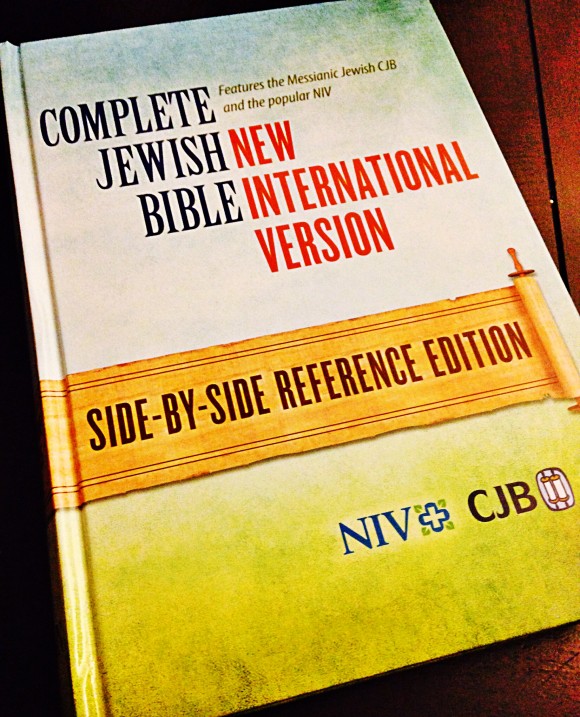
Around 2008, I was in Berean (now Lifeway) Christian Store and found a most interesting book on the shelf, one of those one of these things is not like the other books that grabbed my attention and insisted that it come home with me. It was called the Complete Jewish Bible. It was not at all what I expected and that is neither bad nor good; it simply is…
The Translation: CJB
Complete Jewish Bible (hereafter called CJB) is a very interesting version. I will not call it a translation, because Dr. Stern, the “translator” does not and goes so far as to admit that, at least the Old Testament, is a cross between a paraphrase and a translation (see page xiv of the Introduction to CJB). I am not sure what you would call it; I call it somewhat problematic at the least; if it is a translation, lets make it clear, if a paraphrase let’s make that clear too. CJB is most definitely not a formal equivalence translation by any stretch of the imagination. That is not, per se, a negative. Dynamic Equivalence and Paraphrases both have a well deserved place in any student’s library because they help you to gather a better overall sense of what is being communicated.
There are some problems with CJB one or two of which are quite glaring. Lets look at a couple:
Matthew 16:24 NIV
Then Jesus said to his disciples, “Whoever wants to be my disciple must deny themselves and take up their cross and follow me.
Matthew 16:24 CJB
24 Then Yeshua told his talmidim, “If anyone wants to come after me, let him say `No’ to himself, take up his execution-stake, and keep following me.
The NIV accurately renders stauros as cross (see Strong’s #4716). Had the word xulon been used here, execution stake would have been an acceptable rendering. In a straight reading, the CJB almost sounds like a Jehovah’s Witness wrote it.
Romans 3:23 NIV
For all have sinned, and come short of the glory of God
Romans 3:23 CJB
since all have sinned and come short of earning God’s praise.
Even the Living Bible (a total paraphrase) renders this verse better: Yes, all have sinned; all fall short of God’s glorious ideal.
Also problematic is the fact that in the entirety of Romans, Dr. Stern renders “the Law” as Torah. This is curious. Dr. Stern, being a Jew, would most certainly know that Torah means teaching, not law and the law that Paul refers to is the Law given to Moses at Mount Sinai. I could continue but it would take me several dozen pages to do a complete comparison of the text of CJB with the NIV or any other translation.
Overall, the CJB is not necessarily bad, so long as it is not your primary study Bible. To properly study the Bible, a Formal Equivalence translation is an absolute must (and if you have read any of my reviews, you would see that I recommend the NASB as the best Formal Equivalence you can get). There are a lot of Hebrew words that will be unfamiliar to you if you are not a Jew by birth; fortuitously, the NIV is included to help you make sense of it.
The Translation: NIV2011
NIV2011 is not my favorite translation, in fact it does not even make the top 5 that I use, but I don’t hate it. In fact you may be surprised to learn that I will pick up an NLT before I reach for an NIV. (Don’t stone me yet or call me a heretic) When using an NIV I actually use either my 1978 or 1984 NIV texts. (I prefer the 1978 much the same as I prefer the 1977 NASB; there’s something to be said for the original.)
My only real problem with the NIV 2011 edition is kind of a major one, gender inclusive language. No I am not sexist, but I do think that interpretation is best left up to the expositor in the pulpit not the translator making the text. Women are very special; they are the only aspect of creation that resulted from God seeing something that was not good (It is not good for the man to be alone, Genesis 2:18) and the woman must always be cherished because she is the gift that God made uniquely for the man to bless him and to complement him perfectly. That being said, the Bible was written with certain language that the Holy Spirit superintended and we walk a dangerous road when we try to make Him say something He did not say.
As translations go, NIV2011 is not terrible; but it is not great either. ESV would have been a better choice for this Bible as would NASB and NKJV yet I can understand why NIV2011 was chosen, it remains one of the top selling English Bibles and according to most reports it is the top seller, thus making it a logical choice for Hendrickson
The CJB/NIV2011 Side by Side Reference Bible
Now the review:
1. This Bible is well put together. Anywhere I opened it it laid flat. You will find the text quite easy to read, probably a 9.5 point font maybe 10. Sadly Hendrickson persists in using dreadfully thin paper. This, if you will remember was a major sticking point with me on the Tozer Bible. I would be absolutely shocked if this Bible was using 27gsm or better paper. There is a fair amount of ghosting and there will probably be some bleed through. If you are a note-taker (and I hope you are) you will definitely want to use a ball point pen or a colored pencil as a highlighter is almost guaranteed to bleed through. I do not understand this choice; I also have an NASB Minister’s Bible from Hendrickson and the paper there is more opaque. Hendrickson products are such a joy to hold and so easy on the eyes that I cannot understand why they would choose the paper that they do (cost is my assumption but I personally would rather pay a little more for quality.
2. There is a detailed introduction to the CJB; read it. This introduction is very important because it not only covers the translation methodology but also the layout of a Jewish Bible and a brief overview of how the Bible is used in a Messianic Assembly.
3. Unlike the CJB by itself, this text follows the canonical order of the books of the Bible; part of the fun of the original CJB is the fact that the Bible is laid out according to the Tanakh. Also the Jewish names of each Book of the Bible are there and, while not essential to our salvation, this does serve to make reading this Bible a little more fun/interesting and let’s be honest, God and His Word are meant to be enjoyed.
4. As is to be expected, the NIV puts plenty of translation footnotes in the text. These include variant readings from older manuscripts and alternate translations. (Would be nice if the CJB did so as well.) As for the references, Hendrickson either forgot to include them in my review copy or they are using the term differently. There is no center column reference, side column reference, or end of verse reference. This is not a problem for me as I usually follow a different thought pattern anyway.
5. On page 2087 is a pronunciation glossary. Until you read the CJB text, you will not understand how valuable this is. Most Christians or as my Jewish Christian friends call us, Messianic Gentiles, are not all that familiar with Jewish words so we may have challenges with pronunciation and meanings. Use this tool as often as possible, it may actually be the most helpful resource included with the text.
Would I recommend this Bible? Yes, though again, I am not sure I would recommend it as a primary study tool. It is more of a supplement. That being said, this Bible will certainly give you some unique insight into both the Jewish Mindset and the Hebraic origins of our faith. Overall, I am satisfied but I will recommend that, since Hendrickson has released some NASB Bibles in the past, they should also release this as an NASB/CJB Parallel Bible.

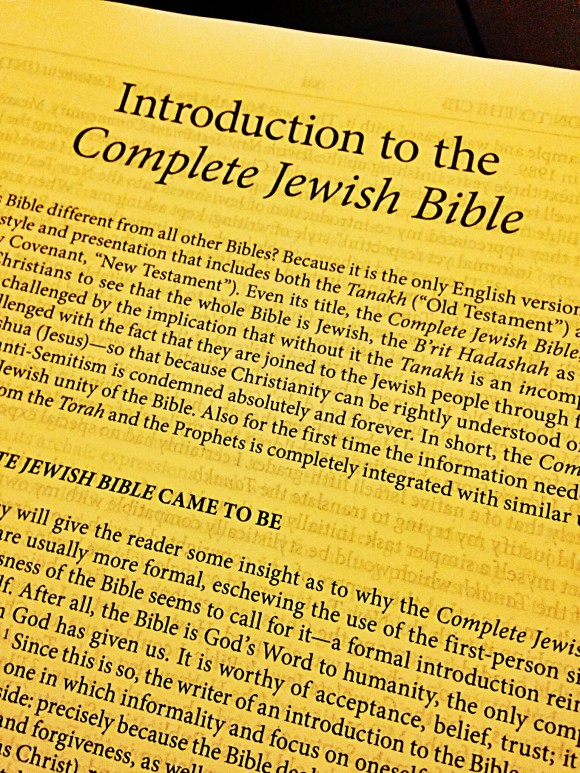
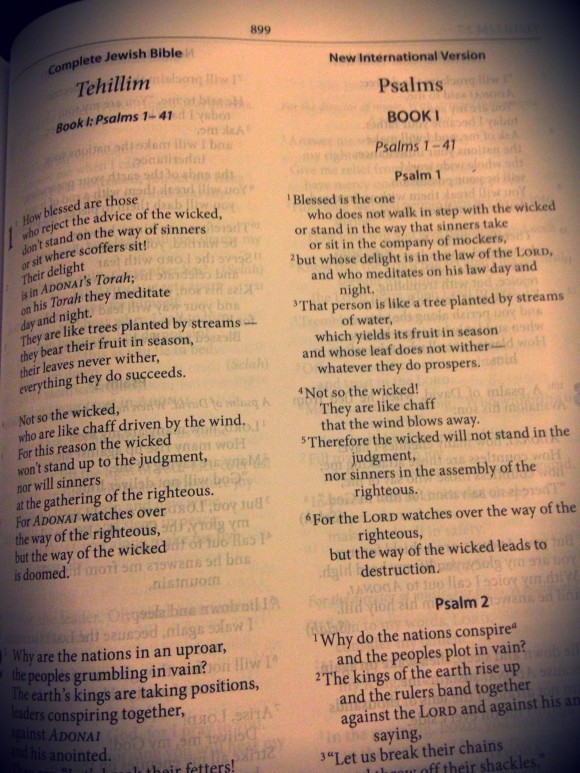
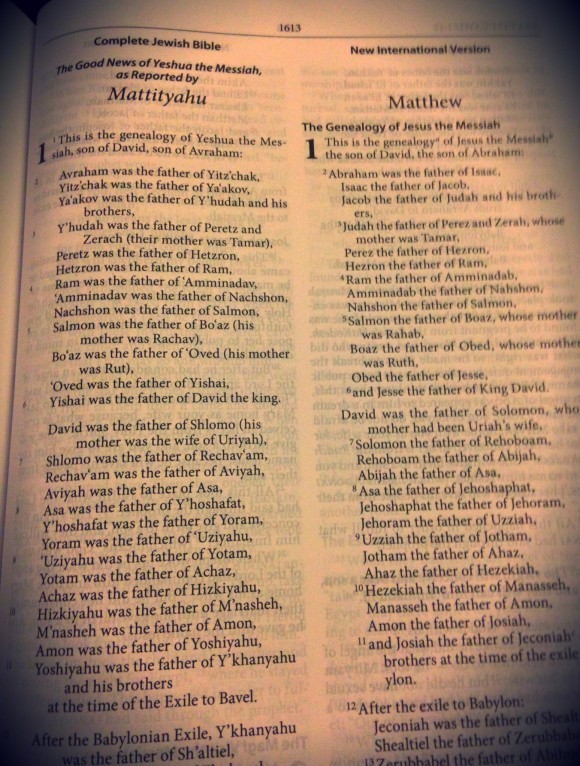
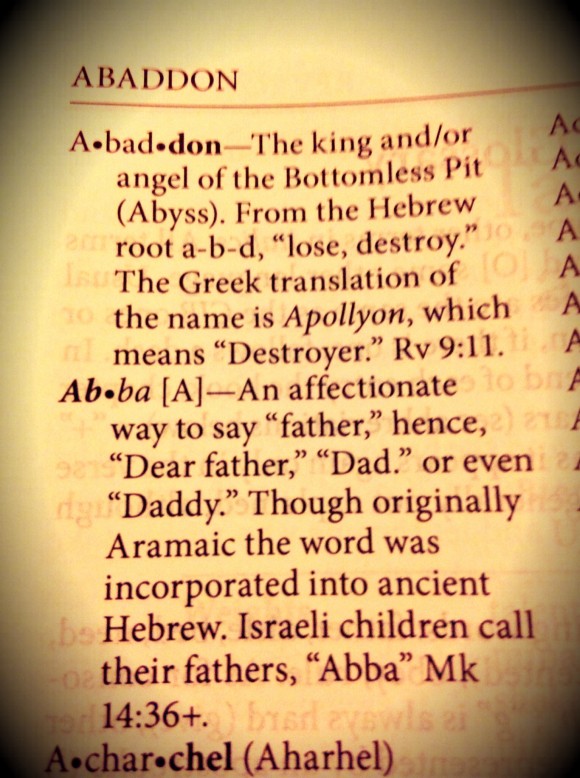
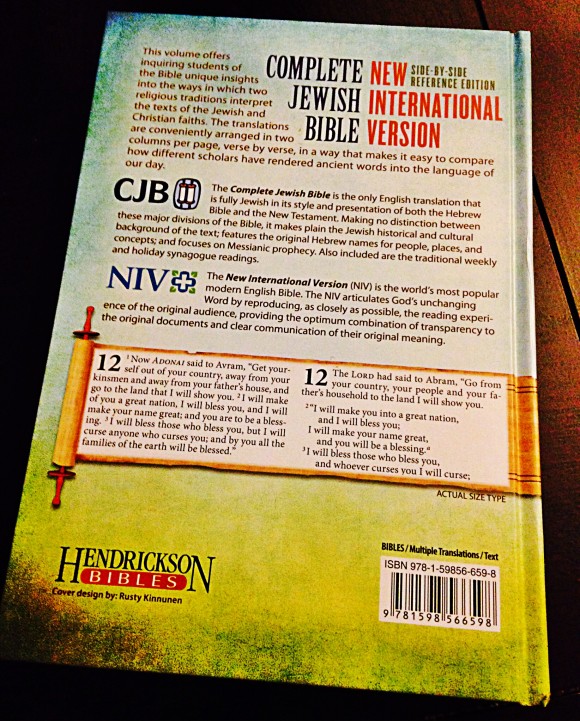
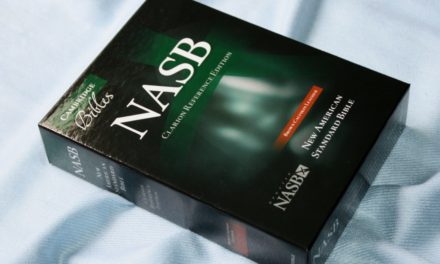


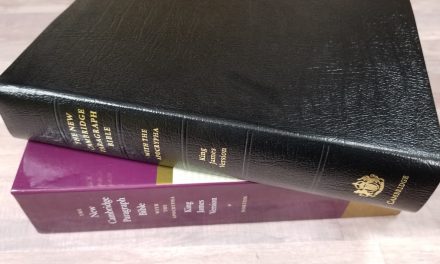





Dear Randy:
I have the same reservations about the NIV that you do, as well as some more. Having said that, I think I may give this product a read, we should all be conversant to the Jewish viewpoint on the Old Testament. I see the Gospel throughout the Old Testament, the New Testament, in my view is built on the testimony of the Old Testament. It will be interesting to read about how Jewish readers view it.
I hope your words about the NIV don’t get you into the same sort of uncomfortable position that I found myself in when I stated what I thought were good reasons for my return to the Authorised translation from the NASB that I had used for many years. I found that the selection of a translation was not only personal and intellectual, but also very emotional for some very good people. Some took me to task for “attacking” the NASB which I respect and used for many years. I think those comments were not justified, and was surprised at the vigor with which those opinions were expressed. Perhaps you will get a pass on your comments, I hope so. I have found all translations have problems of some sort or another, I congratulate you for having the courage to express your opinion on one of the problems of the NIV.
I’ll let you know how the reading of The Complete Jewish Bible goes, right now I’m exploring Tozer.
Yours in Christ
Don Denison
Dear Matthew:
Oh Dear, I’ve done it again, I failed to notice who had written this review. I apologize, but will still stand by my comments. I will be reading this publication because of your excellent review of it, thank you for your good work, God bless you.
Yours in Christ
Don Denison
Don:
It is never a worry that you didn’t catch me as the author.
As to the NIV, Dynamic Equivalent isn’t bad per se; it gives an interesting perspective especially since the human authors most likely had colloquialisms and dialects much the same as we do. Where it becomes a problem is when things like gender neutral language gets added.
I am sure that telling the truth and pointing out a translation’s difficulties will eventually get me in trouble. My main concern is to be faithful to the Lord and His word. If I get in trouble with men, so be it. I hope someday to be found worthy to suffer for His name
Dear Matthew:
I agree completely with your position in regard to the criticism of the NIV vis-a-vis “Gender Neutrality” . I perhaps was not as gentle or tactful as you when I let all know why I left the NASB to return to the Authorised. I thought I had been reasonable, but evidently had not been careful enough with how I stated my reasons. I agree that the original writers knew what they were doing, what sex the subject is was as readily determined then as it is now. If the subject is of the female sex, the descriptive pronoun should be feminine gender, for a male, the opposite. Political Correctness has changed our language/grammar usage so much that gender, a grammatical term that applies to DESCRIBE words, has come to be used as a substitute for the word sex, which describes things that have a sex, sex has many meanings besides a description of an act between males and females. Males and females have a sex, words have a gender. If you will, people are either one sex or the other, we have words that are gender specific to denote which sex pertains. Grammarians will shudder at my explanation, but today in this world most polite folks will not let the word sex out of their mouths, they are too squeamish though if used correctly it is a perfectly good word. We have in the name of fairness (whatever that is) rendered the word sex useless and substituted a grammar descriptive word for it. In the case of the bible, I have to believe that the writers could tell the difference between a male or female subject or object, or if that something has neutral sex qualities. As politically incorrect as it is, the word sex should be the correct one, it is what it is. To make all the same sex is to not translate properly. There should be no prejudicial opinion involved a thing is what it is, male, female, or it.
I really enjoy your reviews, you are thorough and sensitive to the needs of your readers. God Bless you.
Yours in Christ
Don Denison
Michael,
I don’t fully understand your inference about Dr. David Stern as to whether he understands the differences between the Torah/ teaching and the Law given at Mt. Sinai? According to Acts 21 it appears to me there are different expectations for the Gentile and the Jew. Is the Jew exempt from the Law, James the brother of Christ didn’t seem to think so? However, it would seem the Gentile is exempt except for certain stipulations, which appears to be based primarily off the Noahic Covenant. Acts 21: 20-26
http://www.theopedia.com/Noahic_Covenant
If you’re looking for a Messianic Bible try to obtain a copy of the TLV Tree of Life Bible and then give us a review. The Tree of Life Bible is a new translation of the N.T. and uses the JPS Translation for the Old Testament. I believe Michael Brown was involved with this translation of the N.T. as well as Stanley Horton also an AG guy, who Randy might be more familiar with. The Delitzsch Hebrew Gospels released by Vine of David might also be a good resource.
http://youtu.be/UbufgIbpd64
https://www.bible.com/bible/314/jhn.1.tlv
http://www.treeoflifebible.org/
http://vineofdavid.org/resources/dhe/the-delitzsch-hebrew-gospels/
And, since you state that your real problem with the 2011 NIV is Gender Inclusive language, which scriptures are you referring to?
Matthew,
You state in your review that your big issue with the 2011 NIV is the gender inclusive language and that interpretation should be reserved for the expositor in the pulpit and not the translator. But, you never gave any specific examples in regards to your statements about the translation choices in the 2011 NIV. Instead you began a sermon on the uniqueness of the creation of women? Personally, I’ve found that most complaints about the 2011 NIV translation can be easily explained. I don’t know if you’re just parroting something you’ve read or heard, but by not giving specific scriptures I find a portion of your review somewhat misleading.
Norm
http://www.niv-cbt.org/niv-2011-overview/translators-notes/